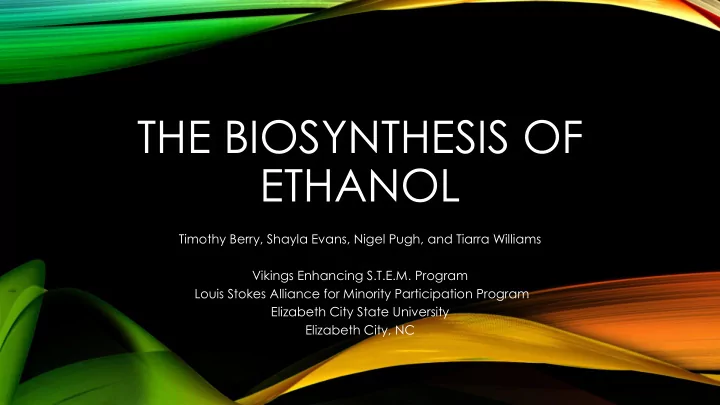

THE BIOSYNTHESIS OF ETHANOL Timothy Berry, Shayla Evans, Nigel Pugh, and Tiarra Williams Vikings Enhancing S.T.E.M. Program Louis Stokes Alliance for Minority Participation Program Elizabeth City State University Elizabeth City, NC
Introduction
RENEWABLE/NON-RENEWABLE SOURCES • Non-Renewable: • Resources that cannot be replaced once supply is used up • Examples: Oil, Uranium, and Coal • Renewable: • Sources that can be replenished naturally with a passage of time • Examples: Soil, Water, and Sunlight
FERMENTATION • Fermentation is a chemical breakdown of a substance by yeast or other microorganisms • Used for thousands of years for baking and brewing
WHAT IS ETHANOL? • An intoxicating agent used in fermentation and distilled liquids • Used in beer and wines • Most widely used in biofuels • Comes from two main sources: Sugarcane and corn
WHAT IS ETHANOL USED FOR? • Solvent used in medicines, cleaning solutions, colognes, and after shave • Clean burning alternative to gasoline • Most gas in the United States is blended with Ethanol • The most ethanol currently in gasoline is 15%
STUDY OF PURPOSE • Synthesize the ethanol and see which of the products produces the most ethanol. • Which test substance is the purest in comparison to pure ethanol?
HYPOTHESIS The bread, sucrose, water, and disodium phosphate mixture would produce the most distilled pure ethanol in comparison to pure ethanol itself.
METHODOLOGY • Make 500 milliliter flasks of sucrose, yeast, disodium phosphate, and water ; bread, sucrose, disodium phosphate, and water; and fructose, disodium phosphate, water, and yeast (Following packet) • Connect flask with glass rod to test tube of calcium carbonate • Let it ferment overnight Picture 1
ethanol’ - is an alcohol which is made by fermenting the sugar and starch components of plant materials by using yeast such as saccharomyces cerevisae. FILTERING PROCESS • Prepare filter paper in Buchner funnel for filtering • Pour fermented solution through Buchner funnel while running vacuum to remove solids Picture 2
DISTILLATION PROCESS • SET UP DISTILLATION APPARATUS ( MAKE SURE ALL PARTS MATCH) • Pour each solution 19/22 or 22/40 500 milliliter flasks • Sit flasks in heating mantle (set on ringstands) • Collect each ethanol sample from each solution Picture 3
PURITY TEST • Dip a capillary tube into each ethanol solution • Boil 500 milliliters of water while inserting capillary tubes beside thermometer into the water • Check tubes to see at what temperature the ethanol boils Picture 4 Picture 5
Distilled Ethanol Bread, Sucrose, Water, Disodium 16 Milliliters Phosphate Yeast, Sucrose, Water, Disodium 23 Milliliters Phosphate Fructose, Yeast, Water, Disodium 38 Milliliters Phosphate Table 1
Purity Test Yeast 23ml H2O Na2 (38mL) Fructose Yeast 23ml H2O Na2 (23mL) Sucrose Bread Sucrose Na2P H2O (16mL) Pure Ethanol 21.62 (Controlled) 99 99.5 100 100.5 101 101.5 102 102.5 Temperature (Celsius) Graph 1
DISCUSSION • Did the results support the hypothesis? • Elements that could have negatively affected the outcome • How could this experiment be improved?
FUTURE WORK • Used for environmental gas conservation • More efficient ways to make common household products such as medicine, cologne, and cleaning supplies
REFERENCES • (n.d.). Retrieved from http://wordnetweb.princeton.edu/perl/webwn?s=ethanol • Dictionary Team. (n.d.). Retrieved from http://dictionary.reference.com/browse/distillation?s=t • Kimbrough, Doris. Fermentation and Distilation . Lab. Wilmington, NC: University of North Carolina at Wilmington, 2000. Document. • Meton, Raja. "Organic Chemistry Lab 1: Biosynthesis of Ethanol." Lab. 2004. • Thompson, John. The Biosynthesis of Ethanol . Lab . Eugene, Oregon: Lane Community College, n.d. Document. • Weeks, M.G. Aspects of Fermentation and Distillation . PhD Thesis. Auckland, New Zealand, n.d. Document. • Kirchoff, M., & Ryan, M. A. (2002). Greener approaches to undergraduate chemistry experiments. . Washington, D.C.: American Chemical Society.
ACKNOWLEDGEMENTS Special thanks to: God, V.E.S.T.E.M. and the L.S.A.M.P. programs and the mentors involved, Mrs. Shanta Outlaw, Ms. Jennifer Vanwyck, Mr. Raynard Townsel, Mrs. Prudentia Ngwainbi Dean Bass, and Dr. Khan for making all this possible aiding in the research and analysis process. This would not have happened without all your help and support. Thanks!
QUESTIONS? COMMENTS?
Recommend
More recommend